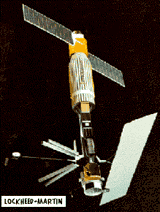Seasat
 Seasat was the first satellite designed for remote sensing of the Earth's oceans with synthetic aperture radar (SAR). The mission was designed to demonstrate the feasibility of global satellite monitoring of oceanographic phenomena and to help determine the requirements for an operational ocean remote sensing satellite system. Specific objectives were to collect data on sea-surface winds, sea-surface temperatures, wave heights, internal waves, atmospheric water, sea ice features and ocean topography. The mission ended on October 10, 1978 due to a failure of the vehicle's electric power system. Although only approximately 42 hours of real time data was received, the mission demonstrated the feasiblity of using microwave sensors to monitor ocean conditions, and laid the groundwork for future SAR missions.
Seasat was the first satellite designed for remote sensing of the Earth's oceans with synthetic aperture radar (SAR). The mission was designed to demonstrate the feasibility of global satellite monitoring of oceanographic phenomena and to help determine the requirements for an operational ocean remote sensing satellite system. Specific objectives were to collect data on sea-surface winds, sea-surface temperatures, wave heights, internal waves, atmospheric water, sea ice features and ocean topography. The mission ended on October 10, 1978 due to a failure of the vehicle's electric power system. Although only approximately 42 hours of real time data was received, the mission demonstrated the feasiblity of using microwave sensors to monitor ocean conditions, and laid the groundwork for future SAR missions.
Spacecraft
The satellite utilized the Agena upper stage to provide satellite bus functions, including power, telemetry (S-band), attitude control, and command and control functions. A sensor
package containing the mission's 5 experiments was attached to the Agena, as were the experiments' antenna systems. The vehicle was 3-axis stabilized using momentum wheels and horizon sensors. The vehicle was oriented with the SAR and other antennas remaining nadir pointing and the Agena rocket nozzle and solar panels zenith pointing.
Payload
Synthetic Aperture Radar (SAR) - used to image the ocean surface (wave patterns),
polar ice caps, snow coverage, and coastal regions. The experiment operated at L-band
(1.275 Ghz) with a 100 km swath, and provided 25 meter vertical resolution. The
experiment used a 2.2 m x 10.7 m corporate feed antenna. Radar Altimeter (ALT) - used to measure wave heights by measuring spacecraft altitude above the ocean surface.
The experiment operated at Ku-band and had 10 cm vertical accuracy. Seasat-A Satellite Scatterometer (SASS) - used to measure wind speed and direction. SASS operated at L-band (1.275 Ghz) and provided accuracies of +/- 2 m/s (speed) and 20 deg. (direction). Scanning Multichannel Microwave Radiometer (SMMR) - used to meaure surface wind speed (+/- 2 m/s), ocean surface temperature (+/- 2 deg C), atmospheric water vapor content, rain rate, and ice coverage. The experiment was passive, and operated at 6.6, 18, 37, 10.7 and 21 Ghz with a 600 km swath width. Visible and
IR Radiometer (VIRR) - used to identify cloud, land and water features (in support of
the other instruments) and provide ocean thermal images. VIRR operated between
0.25-0.73 Ám and 10.5-12.5 Ám, and had a 1900 km swath width with an IFOV of 2-5 km.
| Country of Origin | United States |
| Customer/User | NASA, JPL |
| Manufacturer(s) | Lockheed, Ball Space Systems |
| Size | 21 m long, 1.5 m diameter SAR antenna was 2.1 x 10.7 m |
| Orbit | 805 km circular, near-polar (108 deg inclination) 17 day repeat, then later 3 day repeat |
| Design Life | 1 to 3 years |
| Related Sites | JPL Seasat Page |
Launch Facts
| Name | Int'l Desig. | Date | Site | Vehicle | Orbit | Mass(kg) |
| Notes | ||||||
| Seasat 1 | 1978-064A | 6/27/78 | WSMC | Atlas Agena D | LEO | 2300 |
| Oceanographic | ||||||
Information in The Mission and Spacecraft Library is provided without warranty or guarantee. USE AT YOUR OWN RISK.